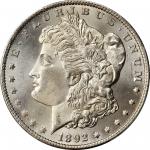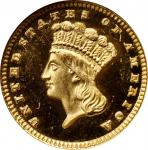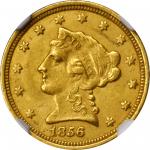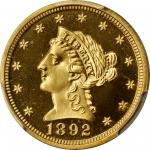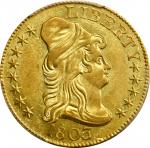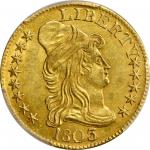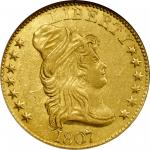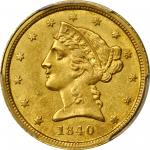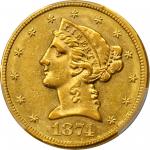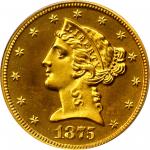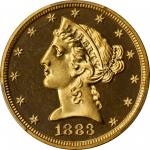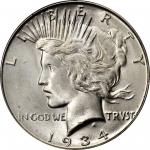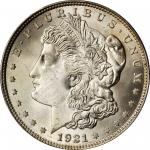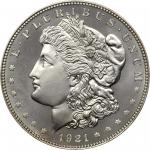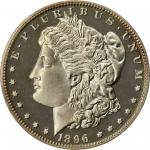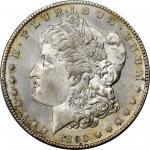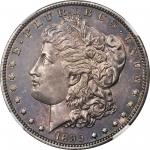1885贸易银元 PCGS Proof 64
1885 Trade Dollar. Proof-64 (PCGS).
Both sides of this legendary rarity in the trade dollar series are dusted with iridescent antique silver toning. A few blushes of slightly warmer sandy-rose tinting are evident, mostly around the obverse periphery and over the lower right reverse. That side of the coin is fully struck with razor sharp detail from the rim to the center, and every one of the eagle's feathers is crisply delineated. The obverse is fully defined overall with a touch of softness confined to stars 5 and 6, which lack radial lines. The top of Liberty's head and the tip of the coronet are also a bit lightly struck, but we stress that most Proof 1885 trade dollars are softly struck to one degree or another along the upper obverse border. This coin is more sharply struck than the Eliasberg specimen, which is soft from stars 5 to 10. Carefully preserved surfaces are fully Choice in quality and offer outstanding visual appeal.
The 1885 trade dollar is one of the greatest of all American numismatic classics, with a ranking of 15 in the popular and influential book 100 Greatest U.S. Coins (5th Edition, 2019) by Jeff Garrett and Ron Guth. The 1885 trade dollar is rarer than the 1787 Brasher doubloon (seven known), is about three times rarer than the 1804 dollar (15 known), is tied with the 1913 Liberty Head nickel (five known), and is nearly on a par with the 1822 half eagle (three known). It is significant to note that neither the Smithsonian Institution nor the American Numismatic Society, possessors of two of the finest cabinets of American coins ever assembled, have either an 1884 or an 1885 trade dollar. Nor does the American Numismatic Association have one. The same can be said for virtually every other collection in existence, public or private, for apart from the piece offered here, just four coins are believed to exist.
Some of the following historical information on the 1885 trade dollar is excerpted and updated from Q. David Bowers' 1997 cataloging of the Eliasberg specimen.
History of the 1885 Trade Dollar
In certain ways the story of the 1885 trade dollar parallels that of the 1884 just given, although with several differences. For starters, the 1885 is twice as rare, and considering that aspect, has appeared on the market less often than the mintage of five coins would suggest. Most of America's truly great collections lacked an example, and today, as noted, the great museums have no 1885 trade dollars either.
The 1885 trade dollar is not mentioned in the Annual Report of the Director of the Mint for that year. Additionally, while the "Die Record Book," a notebook kept in the Die Department of the Philadelphia Mint from 1880 to 1886 by A.W. Downing (with a few notations by A.W. Straub; both men had the same first two initials), mentions an obverse and reverse die made for the Proof 1884 trade dollar in January of that year, no related notation is given for the 1885 trade dollar. These are significant and potentially revealing omissions, although they are by no means conclusive.
Indeed, numismatic scholars are confident that the 1885 trade dollars are products of the United States Mint, and were made in the year indicated. All five coins were certainly struck at the Philadelphia Mint from Proof dies, presumably during a single press run. The obverse and reverse dies for this issue were made from regular Mint master dies and prepared in the normal Proof manner. Apart from the date, a Proof 1885 trade dollar is identical in all aspects to one dated 1884, 1883, or any other earlier date of the Type II/II hub style.
We can even narrow down the exact striking period of these coins to the roughly six month period between January 2, 1885, when the reverse die of the Proof 1884 trade dollar was destroyed, and June 1885, when Archibald Loudon Snowden turned in his resignation as superintendent of the Philadelphia Mint. Snowden enjoyed a long, if interrupted, career at the Mint, first joining its staff in 1857 as a Register under his uncle, Mint Director James Ross Snowden. A. Loudon Snowden's various tenures covered the period of U.S. Mint history when many of the most famous restrikes, patterns and fantasy pieces were clandestinely struck for distribution to contemporary collectors. It is easy to assume that, before his departure in June 1885, Snowden had a hand in the production and/or survival of the five Proof 1885 trade dollars. Conversely, his successor as superintendent of the Philadelphia Mint, Daniel Fox, has no known association with the production or distribution of numismatic rarities and appears to have closely followed the rules that forbade selling patterns, restrikes and similar coins to collectors.
While numismatic scholars are confident of their answers to the questions, "When were the 1885 trade dollars made?" and "Where were the 1885 trade dollars made?" why they were made is less clear and still a topic of debate. Traditional numismatic wisdom has it that these coins were struck clandestinely by or, at the very least, at the direction of A. Loudon Snowden for personal gain. Proof for this theory comes from the lack of official documentation regarding the 1885 trade dollar, as related above. Yet it is not necessarily unusual for such mintages to have been omitted from the records, and other instances occur throughout numismatics.
Those who ascribe to the clandestine striking theory also point to the fact that the 1885 trade dollars were not generally known to numismatists until early in the 20th century. This also means very little, however, as numerous other 19th century rarities, including many patterns, were not known until after the turn of the century, nor were the 1873-CC No Arrows dime, 1854-S quarter eagle, and certain other coins produced during the 19th century. Augustus G. Heaton, who was one of the most careful students of American coins, was not aware of the existence of the 1870-S Liberty Seated silver dollar when he wrote his Mint Marks book in 1893, and Mint records are silent on that coin's production. New discoveries are always being made and will continue to be made. We note as a more modern example the 1978 discovery of the unique 1870-S half dime, an issue that is also not mentioned in Mint records.
That the Mint neither publicized the 1884 and 1885 trade dollars at the time of striking nor made them available on open sale to collectors is not necessarily unusual either. Many highly acclaimed rarities of the era including the 1877 pattern half dollars, the 1872 pattern Amazonian silver coins, the 1879 pattern Schoolgirl dollar, the 1882 pattern Shield Earring dollar, and the Coiled Hair four-dollar gold Stellas of 1879 and 1880 -- to give a very short list -- were obtained only through dealers who enjoyed special connections at the Mint. We are not stating that this was an excellent practice, for it was not. Yet even so, Mint officials and contemporary dealers can be credited with preserving for posterity coins that might not have survived otherwise.
It is highly unlikely that anyone within the Philadelphia Mint in 1884 or 1885 considered these trade dollars to be a significant source of secret profit. First, trade dollars were not popular with numismatists at the time. Second, if they had been made for a profit -- as were, for example, restrikes of the 1856 Flying Eagle cent and the 1804 Class III silver dollar -- they would have been marketed long before the early 20th century.
As related above in our description for the 1884 trade dollar in the E. Horatio Morgan Collection, the Philadelphia Mint had been producing Proof trade dollars for collectors from the start of the series in 1873, and exclusively from 1878 onward. In early 1884, also as related above, Superintendent Snowden received orders from the Treasury Department to cease production, sale and other distribution of trade dollars. The trade dollar was not officially discontinued until 1887, however, so it is possible that Snowden had his staff once again, as they had done in January 1884, make all of the necessary preparations for the striking of Proof 1885 trade dollars for sale to collectors as part of the year's Proof sets. What could have followed is a repeat of what happened with the 1884 trade dollars: Superintendent Snowden acquired five examples from the initial batch of Proof 1885 trade dollars delivered to the cashier. Until the 1930s, it was legal for Mint employees to obtain examples of new coinage in exchange for the equivalent amount of coin or bullion, which is certainly how Snowden acquired the 10 Proof 1884 trade dollars, and could also have been how he acquired the five Proofs of 1885. Shortly thereafter, however, Snowden would have been instructed that trade dollars were not to be included in the 1885 Proof sets; no additional coins were struck after that declaration, and any additional specimens that were still with the cashier would have been destroyed through melting.
While the foregoing scenario makes sense in theory, the exact status of the Proof 1885 trade dollars remains a mystery. They may have been produced clandestinely after all or, like their 1884 counterparts, they could be legitimately produced and obtained survivors from a Proof mintage that was cancelled early in the year, and after Mint employees had already taken the first steps for a large coinage. In the end it matters little, for the extreme rarity of this issue and the desirability of owning an example have been recognized since the early 20th century.
For many years it was generally believed that the 1885 trade dollars, along with those dated 1884, were found by John W. Haseltine in 1901 when going through the numismatic estate of his father-in-law, William K. Idler. Apparently, Idler acquired six 1884 trade dollars from Superintendent Snowden shortly after they were struck. These were added by Idler to silver Proof sets of the year. After Idler's passing in 1901, John W. Haseltine fell heir to his numismatic estate. Haseltine confirmed the existence of 1884 trade dollars in his father-in-law's estate during an address to ANA members gathered in convention in Philadelphia in autumn 1908. This was related in the October-November 1908 issue of The Numismatist, quoted above in our description for the 1884 trade dollar, but repeated here:
"One of the old-time dealers, and also a collector, was the late Mr. William Idler of this city at the time when Mr. Cogan was also a dealer in Philadelphia. Mr. Idler was my father-in-law and he was very reticent about his collection. He would seldom show his coins, even for sale. This was partly caused by the fear that the many pattern and experimental coins he possessed might be seized. Hence the many remarkable pieces that have been found in his collection. Some were not known prior to his death, to be in existence, including the 1884 Trade dollar and some unique United States gold pieces."
It is significant that Haseltine does not mention the 1885 trade dollar in connection with Idler. While Haseltine and his partner Stephen K. Nagy went on to sell several of the 1884 trade dollars -- most notably to Virgil Brand -- no sale of any of the five 1885 trade dollars has ever been positively traced to Haseltine or Nagy. Rather, the earliest known sale of an 1885 took place on April 26, 1911. The buyer was Virgil Brand, perhaps not surprisingly, but the seller was Edgar H. Adams, who was probably offering the coin on behalf of his close associate William H. Woodin. (Pattern enthusiasts will immediately recognize Adams as co-author, with Woodin, of the famous Adams-Woodin reference United States Pattern, Trial, and Experimental Pieces, first published in 1913.) An article in the January 1912 edition of The Numismatist reported that Judson Brenner owned examples of both the 1884 and 1885 trade dollars. The first auction appearance of an 1885 trade dollar was lot 392 in B. Max Mehl's July 1913 sale of the H.O. Granberg Collection. Lot 391 in that sale was an 1884 trade dollar. Granberg exhibited another 1885 trade dollar at the 1914 ANS Exhibition as part of a complete set of trade dollars that also included, of course, the 1884. The fifth and final 1885 trade dollar made its debut in the wider numismatic market in March of 1915 when Edgar H. Adams offered both an 1884 and 1885 trade dollar in an ad in The Numismatist.
Adams, Brenner and Granberg all had close ties to Woodin and, as related above in our description for the E. Horatio Morgan 1884 trade dollar, four of the 10 Proof 1884 trade dollars first surfaced during the four year period from 1912 to 1915, each as part of a two-coin set with an 1885 trade dollar. This presentation was quite different from that of the six 1884 trade dollars that came out through Idler-Haseltine-Nagy, which were part of silver Proof sets -- dime, quarter, half dollar, silver dollar and trade dollar -- assembled by Idler. Woodin is very likely the key to the initial distribution of the 1885 trade dollars, and what links him to Snowden is his purchase, through Haseltine, of the two 1877 pattern half unions from the former superintendent in 1909. When word of this transaction spread, public opinion came out against the sale with many believing that the coins belonged to the Mint Cabinet and should never have been sold. The results of legal proceedings were avoided by a last minute deal in which Woodin agreed to return the coins in exchange for "several trunks" of patterns and other coins that Snowden had acquired during his years at the Mint. The exchange took place in 1910 and, once back in Snowden's possession, the half unions were either returned to the Mint or confiscated.
Given that the 1885 trade dollars first appeared within the five years after the 1910 exchange between Woodin and Snowden, it seems likely that four 1884 trade dollars and all five of the 1885 trade dollars were included in the "several trunks" of coins that Woodin acquired. Four of the 1884 trade dollars were each paired with an 1885 trade dollar and initially sold to or through Edgar H. Adams, Judson Brenner and H.O. Granberg, as above. Adams sold the fifth 1885 trade dollar individually to Virgil Brand (actually the first for which we have a confirmed sale).
Registry of 1885 Trade Dollars
5 Known
The following roster of known specimens of the 1885 trade dollar is updated from Q. David Bowers' standard 1993 reference Silver Dollars and Trade Dollars of the United States: A Complete Encyclopedia, with corrections and additions obtained from the PCGS CoinFacts website and research presented in Heritage's January 2019 FUN Signature Auction. The grades are either those currently assigned by PCGS or NGC or, for the single uncertified specimen, an estimated grade based on historic market appearances. Unfortunately, it is no longer possible to determine how the Judson Brenner, one of the H.O. Granberg and one of the Edgar H. Adams specimens fit into the current provenance chains so, where appropriate, we have used the terminology "unknown intermediaries" after William Woodin, who probably acquired all five examples from Philadelphia Mint Superintendent A. Loudon Snowden in 1910.
1 - PCGS Proof-66+ Cameo. The Eliasberg Specimen. Ex Philadelphia Mint Superintendent A. Loudon Snowden, 1885; William H. Woodin, 1910 (probably); unknown intermediaries; William Cutler Atwater; B. Max Mehl's sale of the William Cutler Atwater Collection, June 1946, lot 378; Louis E. Eliasberg, Sr.; our (Bowers and Merena's) sale of the Louis E. Eliasberg, Sr. Collection, April 1997, lot 2354; Jay Parrino; Legend Numismatics; Bruce Morelan, 1999; John Albanese, 2006; Heritage, privately, 2006; private collection; Heritage's sale of the Greensboro Collection, Part VII, January 2019 FUN Signature Auction, lot 4553.
2 - PCGS Proof-64. The Olsen-French Specimen. Ex Philadelphia Mint Superintendent A. Loudon Snowden, 1885; William H. Woodin, 1910 (probably); unknown intermediaries; B. Max Mehl's sale of the Fred Olsen Collection, November 1944, lot 1767; George Sealy Ewalt; our (Stack's) sale of the George Sealy Ewalt Collection, November 1965, lot 43; Leo A. Young; RARCOA's session of Auction '80, August 1980, lot 1626; Julian Leidman; Mike Follett; private collection; RARCOA's session of Auction '84, July 1984, lot 1810; John N. Rowe, III; L.R. French, Jr.; our (Stack's) sale of the L.R. French, Jr. Collection, January 1989, lot 202; Charles Barasch (International Coins & Currency, Inc.), circa 1992; E. Horatio Morgan Collection. The present example.
3 - PCGS Proof-63+ Cameo. The Amon G. Carter Specimen. Ex Philadelphia Mint Superintendent A. Loudon Snowden, 1885; William H. Woodin, 1910 (probably); unknown intermediaries; Waldo C. Newcomer (per Carl Carlson), displayed at the 1916 ANA Convention; "Colonel" E.H.R. Green; Burdette G. Johnson; Jack Roe; B. Max Mehl's Ryan, Roe and Waltman Collections sale, June 1945, lot 628; Jerome Kern; B. Max Mehl's sale of the Jerome Kern Collection, May 1950, lot 897; Amon Gamaliel Carter, Sr.; Amon G. Carter, Jr.; our (Stack's) sale of the Amon G. Carter, Jr. Family Collection, January 1984, lot 441; Kevin Lipton; Superior's session of Auction '84, July 1984, lot 192; Fred Fredericks; Superior's L.W. Hoffecker Collection sale, February 1987, lot 1446B; Eugene Worrell; Superior's sale of the Worrell Collection, September 1993, lot 1325; our (Stack's) sale of the L.K. Rudolf Collection, May 2003, lot 2175; Legend Numismatics; Simpson Collection.
4 - PCGS Proof-62. The Farouk-Norweb Specimen. Ex Philadelphia Mint Superintendent A. Loudon Snowden, 1885; William H. Woodin, 1910 (probably); H.O. Granberg; B. Max Mehl's sale of the H.O. Granberg Collection, July 1913, lot 392; Ruth Green, advertised in the December 1941 issue of The Numismatist; King Farouk of Egypt; Sotheby's sale of the Palace Collections of Egypt, February 1954, lot 1680; Ambassador and Mrs. R. Henry Norweb; our (Bowers and Merena's) sale of the Norweb Collection, Part II, March 1988, lot 1848; Dan Drykerman (American Coin Portfolios); private New York Collection; Bowers and Merena Galleries, privately, March 20, 1992; Q. David Bowers (personal collection), March 23, 1992; Richmond Collection; David Lawrence's sale of the Richmond Collection, Part II, November 2004, lot 1569.
5 - Brilliant Proof. The Adolphe Menjou Specimen. Ex Philadelphia Mint Superintendent A. Loudon Snowden, 1885; William H. Woodin, 1910 (probably); Edgar H. Adams, sold to the following on April 26, 1911; Virgil Brand; Armin Brand; Burdette G. Johnson, on consignment November 2, 1936, sold November 1937; Clinton Hester; Numismatic Gallery's Adolphe Menjou Collection sale, June 1950, lot 2041; Benjamin Stack (Imperial Coin Company), advertised an 1885 trade dollar in The Numismatic Scrapbook Magazine, March 1955, along with an 1884 trade dollar; W.G. Baldenhofer; our (Stack's) Farish-Baldenhofer Sale, November 1955, lot 1040; private collection; Julian Leidman, Mike Brownlee and Hugh Sconyers, exhibited at Stack's bourse table at the 1974 ANA Convention, and sold immediately thereafter to the following, along with an 1884 trade dollar; James Halperin, featured in February 1975 issue of The Numismatist; John Kamin (The Forecaster Moneyletter); private collection.
There are several notes concerning 1885 trade dollars which cannot be specifically attributed today to one of the five known specimens, but which, undoubtedly, are part of the registry of this issue:
-An article in the January 1912 edition of The Numismatist reported that Judson Brenner owned examples of both the 1884 and 1885 trade dollars. Brenner almost certainly acquired these coins from William H. Woodin; the 1885 is #1, 2 or 3 above.
-In addition to the specimen offered as lot 392 in B. Max Mehl's July 1913 sale of the H.O. Granberg Collection (#4 above), Granberg owned a second 1885 trade dollar that he exhibited at the 1914 ANS Exhibition as part of a complete set of trade dollars that also included, of course, the 1884. This 1885 is #1, 2 or 3 above.
-The final 1885 trade dollar to make its debut in the wider numismatic market is the specimen that Edgar H. Adams offered in the March 1915 issue of The Numismatist, alongside an 1884 trade dollar. This 1885 is #1, 2 or 3 above.
-In The Numismatist, June 1944, p. 546, the Celina Coin Company advertised a complete set of Proof trade dollars, including these listings: "1884 Very Rare" and "1885 Excessively Rare." These were sold by Burdette G. Johnson from the "Colonel" E.H.R. Green estate to the Brandts brothers (Carl and Ted). In a subsequent issue of The Numismatist, only the 1884 was listed, indicating that the 1885 had been sold separately. This 1885 is different from #3 above, which was also owned by "Colonel" Green at one time.
-Burdette G. Johnson offered 1885 trade dollars to Stack's on August 23, 1943 and B. Max Mehl on April 3, 1944.
Provenance: From the E. Horatio Morgan Collection. Earlier ex Philadelphia Mint Superintendent A. Loudon Snowden, 1885; William H. Woodin, 1910 (probably); unknown intermediaries; B. Max Mehl's sale of the Fred Olsen Collection, November 1944, lot 1767; George Sealy Ewalt; our (Stack's) sale of the George Sealy Ewalt Collection, November 1965, lot 43; Leo A. Young; RARCOA's session of Auction '80, August 1980, lot 1626; Julian Leidman; Mike Follett; private collection; RARCOA's session of Auction '84, July 1984, lot 1810; John N. Rowe, III; L.R. French, Jr.; our (Stack's) sale of the L.R. French, Jr. Collection, January 1989, lot 202; Charles Barasch (International Coins & Currency, Inc.), circa 1992.



